|
|
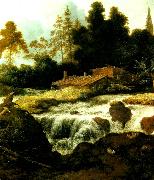 |
allart van everdingen
|
|
Allaert van Everdingen (bapt. 18 June 1621 Alkmaar - buried 8 November 1675, Amsterdam), was a Dutch Golden Age painter and printmaker in etching and mezzotint.
Van Everdingen was the son of a government clerk at Alkmaar. He and his older brothers, the painters Jan and Caesar van Everdingen, according to Arnold Houbraken, were taught by Roelandt Savery at Utrecht. Allaert moved in 1645 to Haarlem, where he studied under Pieter de Molijn, and finally settled about 1657 at Amsterdam, where he died in 1675. |
|
|
|
 |
ALLORI Cristofano
|
|
Italian Baroque Era Painter, 1577-1621
Allori was born at Florence and received his first lessons in painting from his father, Alessandro Allori, but becoming dissatisfied with the hard anatomical drawing and cold coloring of the latter, he entered the studio of Gregorio Pagani (1558-1605) who was one of the leaders of the late Florentine school, which sought to unite the rich coloring of the Venetians with the Florentine attention to drawing. Allori also appears to have worked under Cigoli.
His pictures are distinguished by their close adherence to nature and the delicacy and technical perfection of their execution. His technical skill is shown by the fact that several copies he made of Correggio's works were thought to be duplicates by Correggio himself. His extreme fastidiousness limited the number of his works. Several specimens are to be seen at Florence and elsewhere.
The finest of his works is his Judith with the Head of Holofernes. It exists in two copies in the Pitti Palace in Florence and in the Queen's Gallery in London. The model for the Judith was his mistress, the beautiful Mazzafirra, who is also represented in his Magdalene; and the head of Holofernes is generally supposed to represent himself. |
|
 |
ALLORI Alessandro
|
|
Italian Mannerist Painter, 1535-1607
Born in Florence. After the death of his father in 1540 he was brought up and trained in art by a close friend, often referred to as his 'uncle', the mannerist painter Agnolo Bronzino, whose name he sometimes assumed in his pictures. In some ways, Allori is the last of the line of prominent Florentine painters, of generally undiluted Tuscan artistic heritage: Andrea del Sarto worked with Fra Bartolomeo (as well as Leonardo Da Vinci), Pontormo briefly worked under Andrea, and trained Bronzino, who trained Allori. Subsequent generations in the city would be strongly influenced by the tide of Baroque styles pre-eminent in other parts of Italy.
Freedburg derides Allori as derivative, claiming he illustrates "the ideal of Maniera by which art (and style) are generated out of pre-existing art." The polish of figures has an unnatural marble-like form as if he aimed for cold statuary. It can be said of late phase mannerist painting in Florence, that the city that had early breathed life into statuary with the works of masters like Donatello and Michelangelo, was still so awed by them that it petrified the poses of figures in painting. While by 1600 the Baroque elsewhere was beginning to give life to painted figures, Florence was painting two-dimensional statues. Furthermore, in general, with the exception of the Contra Maniera artists, it dared not stray from high themes or stray into high emotion. |
|
 |
Alma-Tadema, Sir Lawrence
|
|
b.Jan. 8, 1836, Dronrijp, Netherlands.
d.June 25, 1912, Wiesbaden, Germany.
Painter and designer of Dutch birth. The son of a notary, Alma-Tadema demonstrated an early artistic ability. In 1852 he entered the Antwerp Academy, where he studied under Gustaf, Baron Wappers, and Nicaise de Keyser. An important influence at this time was Louis De Taye, Professor of Archaeology at the academy and a practising artist. Alma-Tadema lived and worked with De Taye from 1857 to 1859 and was encouraged by him to depict subjects from the early history of France and Belgium. This taste for historical themes increased when Alma-Tadema entered Baron Henri Leys studio in 1859 and began assisting him with his monumental frescoes for the Antwerp Town Hall. While in Leys studio, Alma-Tadema produced several major paintings, for example the Education of the Children of Clovis (1861; ex-Sir John Pender priv. col., see Zimmern, p. 3) and Venantius Fortunatus Reading his Poems to Radagonda (1862; Dordrecht, Dordrechts Mus.), which are characterized by their obscure Merovingian subject-matter, rather sombre colouring and close attention to detail. |
|
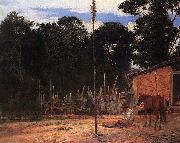 |
Almeida Junior
|
|
(8 May 1850 ?C 13 November 1899) was a Brazilian painter of the 19th century. He is widely regarded as the most important Brazilian realist painter of the 19th century, and a major inspiration for the modernist painters. While most Brazilian academic artists made their fame painting mythological or historical subjects, Almeida Junior would become popular for painting rural figures, especially farmers and the caipira, the countrymen that are a kind of a symbol of the rural areas of the São Paulo state.
While most realist painters used farmers and countrymen as an allegory of workers, Almeida Junior would paint his caipiras mostly on leisure time. He would also produce touching images of upscale landowners. The Bandeirantes, the ruthless explorers of colonial Brazil, would be depicted in the A partida da monção, showing an expedition on the Tiet?? River.
Almeida Junior was born in the city of Itu, then a small town in the state of São Paulo. After becoming a sensation in his town he would be invited to study in the Brazilian Imperial Fine Arts Academy of Rio de Janeiro, but in 1876 would study in France after being granted a scholarship by emperor Pedro II of Brazil in person in the city of Moji-Mirim. He would have Alexandre Cabanel as one of his masters.
He admired the French realist and naturalist painting (a major influence at his work), and, after returning to Brazil in 1882, became of the leading names in Brazilian realist painting.
He was stabbed to death by the husband of his mistress on November 13, 1899 in Piracicaba.
|
|
|
|
 |
Alois Hans Schram
|
|
Alois Hans Schram
(1864 - 1919)
Alois Hans Schram was born in Vienna on August 20th. He was a painter and sculptor of historical subjects, figures, nudes, portraits, scenes with figures, genre scenes, local scenes, interiors with figures, landscapes with figures, urban landscapes, waterscapes and seascapes. |
|
 |
Alonso Berruguete
|
|
(Alonso Berruguete) (c. 1488 - 1561) was a Spanish painter, sculptor and architect. He is considered to be the most important sculptor of the Spanish Renaissance, and is known for his emotive sculptures depicting religious ecstasy or torment.
Born in the town of Paredes de Nava, Berrugete studied art under the tutelage of his father, the painter Pedro Berruguete. Following his father's death in 1504, Berruguete travelled to Italy to continue with his study of art, spending most of his time in Florence and Rome. It is here that he studied sculpture under the Italian Master, Michelangelo. His paintings produced in Italy showed a mannerist influence, with his art being compared with contemporaries such as Jacopo Pontormo and Rosso Fiorentino.
Berruguete returned to Spain in 1517, and in 1518, was appointed to the position of court painter and sculptor by Charles V of Spain. From this point in his career forward, Berruguete concentrated on sculpture. Works of his include an altar piece at the Irish college in Salamanca (1529-1533), choir stalls at the Cathedral of Toledo (1539-1543) and a tomb for the Archbishop of Toledo Juan de Tavera at the hospital that Tavera founded, the hospital of St. John the Baptist in Toledo (1552-1561). |
|
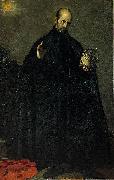 |
Alonso Cano
|
|
(19 March 1601 - 3 September 1667) was a Spanish painter, architect and sculptor born in Granada. He learned architecture from his father, Miguel Cano; painting in the academy of Juan del Castillo, and from Francisco Pacheco the teacher of Velezquez; and sculpture from Juan Martenez Montañ's. As a sculptor, his most famous works are the Madonna and Child in the church of Lebrija (also called Nebrija), and the colossal figures of San Pedro and San Pablo.
He was made first royal architect, painter to Philip IV, and instructor to the prince, Balthasar Charles, Prince of Asturias.The King gave him the church preferment of a canon of the Granada Cathedral (1652), in order to take up a position as chief architect of the cathedral, where his main achievement in architecture was the façade, designed at the end of his life and erected to his design after his death.
Ideal portrait of a Spanish King.He was notorious for his ungovernable temper; and it is said that once he risked his life by committing the then capital offence of dashing to pieces the statue of a saint, when in a rage with the purchaser who begrudged the price he demanded. According to another story, he found his house robbed after coming home one evening, his wife murdered, and his Italian servant fled. Notwithstanding the presumption against the fugitive, the magistrates condemned Cano, because he was of a jealous temper. Upon this he fled to Valencia, but afterwards returned to Madrid, where he was put to the torture, which he endured without incriminating himself, and the king received him into favour.
After the death of his wife he took Holy Orders as a protection from farther prosecution, but still continued his professional pursuits. He died in 1676. In his last moments, when the priest held to him a crucifix, he told him to take it away; according to the Catholic Encyclopedia, this was because the priest gave the Sacrament to conversos.
|
|
 |
Alonso Sanchez Coello
|
|
Alonso Sachez Coello (1531/32 -August 8, 1588) was a portrait painter of the Spanish Renaissance and one of the pioneers of the great tradition of Spanish portrait painting.
Alonso Sachez Coello was born in Benifairode les Valls, near Valencia, and spent his childhood there, until the death of his father when he was around ten years old. He was educated in Portugal at his grandfather's home. Coello's years in Portugal and his family name of Portuguese origin led to a long-standing belief that he was in fact Portuguese. His grandfather (after whom he was named) was in the service of King John III of Portugal who sent the young painter to study with Anthonis Mor (also known as Antonio Moro) in Flanders around 1550. He was under the service of Antoine de Granville, bishop of Arras, learning from Mor. While studying in Flanders, Coello also spent time copying some of Titian's works. |
|
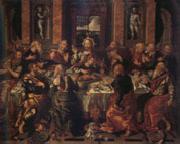 |
Alonso Vazquez
|
|
Spanish
?-1608
was a Spanish sculptor and painter of the Renaissance period. Vazquez was born in Ronda, and learned painting in the school of Arfian at Seville. He passed through the usual apprenticeship of painting "sargas" and at length painted frescoes and oil-pictures. For the Cathedral and the convents of St. Francis and St. Paul, he painted a variety of works, no longer extant. He painted a series of canvases on the life of St. Raymond, for the cloister of the friars of the order of Mercy. Vazquez was one of the artists chosen by the city of Seville to paint the great catafalque erected in the Cathedral, at the time of public mourning for the death of Philip II. He died either in Seville or in Mexico, |
|
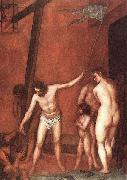 |
Alonzo Cano
|
|
Alonzo Cano or Alonso Cano (19 March 1601 - 3 September 1667) was a Spanish painter, architect and sculptor born in Granada. He learned architecture from his father, Miguel Cano;painting in the academy of Juan del Castillo, and from Francisco Pacheco the teacher of Velezquez; and sculpture from Juan Martenez Montañes. As a sculptor, his most famous works are the Madonna and Child in the church of Lebrija (also called Nebrija), and the colossal figures of San Pedro and San Pablo.
He was made first royal architect, painter to Philip IV, and instructor to the prince, Balthasar Charles, Prince of Asturias. The King gave him the church preferment of a canonof the Granada Cathedral (1652), in order to take up a position as chief architect of the cathedral, where his main achievement in architecture was the façade, designed at the end of his life and erected to his design after his death.[citation needed]
Ideal portrait of a Spanish King.He was notorious for his ungovernable temper; and it is said that once he risked his life by committing the then capital offence of dashing to pieces the statue of a saint, when in a rage with the purchaser who begrudged the price he demanded.[1] According to another story, he found his house robbed after coming home one evening, his wife murdered, and his Italian servant fled. Notwithstanding the presumption against the fugitive, the magistrates condemned Cano, because he was of a jealous temper. Upon this he fled to Valencia, but afterwards returned to Madrid, where he was put to the torture, which he endured without incriminating himself, and the king received him into favour.
After the death of his wife he took Holy Orders as a protection from farther prosecution, but still continued his professional pursuits. He died in 1676. In his last moments, when the priest held to him a crucifix, he told him to take it away; according to the Catholic Encyclopedia, this was because the priest gave the Sacrament to conversos. |
|
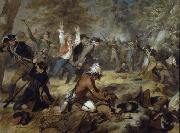 |
Alonzo Chappel
|
|
Alonzo Chappel (1828 - 1887) was an American painter, best known for paintings depicting personalities and events from the American Revolution and early 19th-century American history.
Chappel was born in New York City and died in Middle Island, New York. |
|
|
|
|
|
 |
Alphonse Legros
|
|
Alphonse Legros (8 May 1837 - 8 December 1911), painter, etcher and sculptor was born in Dijon. His father was an accountant, and came from the neighbouring village of Veronnes. Young Legros frequently visited the farms of his relatives, and the peasants and landscapes of that part of France are the subjects of many of his pictures and etchings. He was sent to the art school at Dijon with a view to qualifying for a trade, and was apprenticed to Maître Nicolardo, house decorator and painter of images. In 1851 Legros left for Paris to take another situation; but passing through Lyon he worked for six months as journeyman wall-painter under the decorator Beuchot, who was painting the chapel of Cardinal Bonald in the cathedral.
|
|
 |
Alphonse Mucha
|
|
1860-1939
Czech
Alfons Maria Mucha was born in the town of Ivančice, Moravia (today's region of Czech Republic). His singing abilities allowed him to continue his education through high school in the Moravian capital of Brno, even though drawing had been his first love since childhood. He worked at decorative painting jobs in Moravia, mostly painting theatrical scenery, then in 1879 moved to Vienna to work for a leading Viennese theatrical design company, while informally furthering his artistic education. When a fire destroyed his employer's business in 1881 he returned to Moravia, doing freelance decorative and portrait painting. Count Karl Khuen of Mikulov hired Mucha to decorate Hrusovany Emmahof Castle with murals, and was impressed enough that he agreed to sponsor Mucha's formal training at the Munich Academy of Fine Arts.
Poster of Maude Adams as Joan of Arc, 1909Mucha moved to Paris in 1887, and continued his studies at Academie Julian and Academie Colarossi while also producing magazine and advertising illustrations. Around Christmas 1894, Mucha happened to drop into a print shop where there was a sudden and unexpected demand for a new poster to advertise a play starring Sarah Bernhardt, the most famous actress in Paris, at the Theatre de la Renaissance. Mucha volunteered to produce a lithographed poster within two weeks, and on 1 January 1895, the advertisement for Gismonda appeared on the streets of the city. It was an overnight sensation and announced the new artistic style and its creator to the citizens of Paris. Bernhardt was so satisfied with the success of that first poster that she entered into a 6 years contract with Mucha.
Mucha produced a flurry of paintings, posters, advertisements, and book illustrations, as well as designs for jewellery, carpets, wallpaper, and theatre sets in what was initially called the Mucha Style but became known as Art Nouveau. Mucha's works frequently featured beautiful healthy young women in flowing vaguely Neoclassical looking robes, often surrounded by lush flowers which sometimes formed haloes behind the women's heads. In contrast with contemporary poster makers he used paler pastel colors. The 1900 Universal Exhibition in Paris diffused the "Mucha style" internationally. He decorated the Bosnia and Herzegovina Pavilion and collaborated in the Austrian one. His Art Nouveau style was often imitated. However, this was a style that Mucha attempted to distance himself from throughout his life; he insisted always that, rather than adhering to any fashionable stylistic form, his paintings came purely from within and Czech art. He declared that art existed only to communicate a spiritual message, and nothing more; hence his frustration at the fame he gained through commercial art, when he wanted always to concentrate on more lofty projects that would ennoble art and his birthplace.
|
|
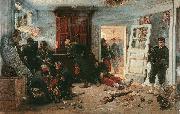 |
Alphonse-Marie-Adolphe de Neuville
|
|
(31 May 1835 - 18 May 1885) was a French Academic painter who studied under Eugene Delacroix. His dramatic and intensely patriotic subjects illustrated episodes from the Franco-Prussian War, the Crimean War, the Zulu War and portraits of soldiers. Some of his works have been collected by the Hermitage Museum in St. Petersburg and by the Metropolitan Museum in New York.
The Last Cartridges, 1873
The Defence of Rorke's Drift, oil on canvas painting by Alphonse-Marie-Adolphe de Neuville, 1880, Art Gallery of New South Wales. This incident occurred on 22 January 1879, in the Anglo-Zulu War.
La bataille de VillersexelHe was born to wealthy parents at Saint-Omer, Pas-de-Calais. From school he went to college, where he took his degree of bachelier -lettres. In spite of the opposition of his family he entered the naval school at Lorient, and it was there, in 1856, that his artistic instincts first declared themselves.
After being discouraged by several painters of repute, he was admitted to work in François-Edouard Picot's studio. He did not remain there long, and he was painting by himself when he produced his first picture, The Fifth Battalion of Chasseurs at the Gervais Battery (Malakoff). In 1860 Neuville painted an Episode of the taking of Naples by Garibaldi for the Artists' Club in the rue de Provence, and sent to the Paris Salon in 1861 The Guard Chasseurs in the Trenches of the Mamelon Vert.
He participated in illustrating the Hetzel editions of Twenty Thousand Leagues Under the Sea. He also illustrated Le Tour du monde and Guizot's History of France. At the same time he painted a number of remarkable pictures: The Attack in the Streets of Magenta by Zouaves and the Light Horse (1864), A Zouave Sentinel (1865), The Battle of San Lorenzo (1867), and Dismounted Cavalry crossing the Tchernaia (1869). In these he showed peculiar insight into military life, but his full power was not reached until after the Franco-Prussian War. He then aimed at depicting in his works the episodes of that war, and began by representing the Bivouac before Le Bourget (1872). His fame spread rapidly, and was increased by The Last Cartridges (1873), memorializing an episode involving the Blue Division of the French marines, in which it is easy to discern the vast difference between the conventional treatment of military subjects, as practised by Horace Vernet, and that of a man who had lived the life that he painted.
In 1874 the Fight on a Railroad was not less successful, and was followed by the Attack on a House at Villersexel (1875) and the Railway Bridge at Styring (1877). In 1878 the painter exhibited (not at the Great Exhibition) Le Bourget, the Surprise at Daybreak, The Intercepted Despatch-bearer, and a considerable number of drawings. He also exhibited in London some episodes of the Zulu War. Fifty thousand people paid to see his impression of The Defence of Rorke's Drift (1880), which the infant Art Gallery of New South Wales in Sydney paid a large sum to acquire.
In 1881 he was made an officer of the Legion d'honneur for The Cemetery of Saint-Privat and The Despatch-bearer and the "Huns in the Battle of Chalon." During these years Neuville was at work with Édouard Detaille on an important though less artistic work, The Panorama of Rezonville. Neuville died in Paris on May 18, 1885. At the sale of his works the state purchased for the Palais du Luxembourg the Bourget and the Attack on a Barricaded House, with a water-color The Parley, and a drawing of a Turco in Fighting Trim.
|
|
 |
ALSLOOT, Denis van
|
|
Flemish painter (b. 1570, Mechlin, d. 1628, Bruxelles)
He initially painted using the style of Gillis van Coninxloo, but after 1610 gradually developed a style of his own. This style can be seen in paintings such as The feast of the Ommegang (Museo del Prado, Madrid) and Procession to Mary at the Zavel in Brussels (Victoria and Albert Museum, London).
At the beginning of the 17th century, in either 1600 or 1606, his career rose when he served as court painter to Albert and Isabella.
Hendrick de Clerck painted sometimes the people in his works.
Van Alsloot's work can be regarded as a precursor to modern Landscape art. |
|
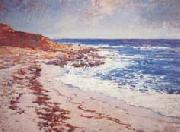 |
Alson Clark
|
|
1876-1949
was an American Impressionist painter best remembered for his impressionist landscapes. Born in Chicago, Illinois, his art education included training at the Art Institute of Chicago (where he enrolled at Saturday classes at the age of 11), the Art Students League of New York, and in the atelier of William Merritt Chase. He spent much of his early career working in Paris, France. He served in the US Army as an aerial photographer during World War I. In 1920 he and his wife relocated to Pasadena, California. He taught fine art at Occidental College, and was director of the Stickney Memorial School of Art in Pasadena. His memberships in arts organizations included the Pasadena Society of Artists and the California Art Club. In addition to landscape paintings, Alson Clark painted murals for the Cathay Circle Theatre in Los Angeles, and the fire curtain of the Pasadena Playhouse, depicting a Spanish galleon in full sail. A group of murals completed in 1929 can still be seen at the former 1st Trust & Savings Bank at 587 East Colorado Boulevard in Pasadena, California. |
|
|
|
 |
ALTDORFER, Albrecht
|
|
German Northern Renaissance Painter, ca.1480-1538
Albrecht Altdorfer (c. 1480 near Regensburg ?C 12 February 1538 in Regensburg) was a German painter, printmaker and architect of the Renaissance era, the leader of the Danube School in southern Germany, and a near-contemporary of Albrecht D??rer. He is best known as a significant pioneer of landscape in art.
He most often painted religious scenes, but is mainly famous as the first frequent painter of pure landscape, and also compositions dominated by their landscape. Taking and developing the landscape style of Lucas Cranach the Elder, he shows the hilly landscape of the Danube valley with thick forests of drooping and crumbling firs and larches hung with moss, and often dramatic colouring from a rising or setting sun. His Landscape with footbridge (National Gallery, London) of 1518-20 is claimed to be the first pure landscape in oil. [1] He also made many fine finished drawings, mostly landscapes, in pen and watercolour. His best religious scenes are intense, sometimes verging on the expressionistic, and often depict moments of intimacy between Christ and his mother, or others. His most famous religious artwork is the The Legend of St. Sebastian and the Passion of Christ that decorated the altar in the St. Florian monastery in Linz, Austria. He often distorts perspective to subtle effect. His donor figures are often painted completely out of scale with the main scene, as in paintings of the previous centuries. He also painted some portraits; overall his painted oeuvre was not large. |
|
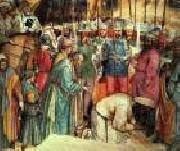 |
ALTICHIERO da Zevio
|
|
Italian Gothic Era Painter, ca.1330-1390
Altichiero da Verona (also called Aldighieri da Zevio; c. 1330 ?C c. 1390) was an Italian painter of the Gothic style. A follower of Giotto, Altichiero is credited with founding the Veronese school. He worked in Verona and Padua ?? works by him survive in the church of Sant'Anastasia in Verona and in the basilica of Sant'Antonio and the Oratorio di San Giorgio in Padua (where the credit for the work has been generally shared with Jacopo d'Avanzi, about whom little is known).
Altichiero was probably born somewhere near Zevio. He became an important member of the della Scala's household, and around 1364 painted a series of frescoes based upon Flavius Josephus's The Wars of the Jews at the della Scala palace of Sala del Podest??.
There are frescoes by him in the Basilica of Saint Anthony of Padua. In conjunction with D'Avanzo Veronese, he frescoed the chapel of St. James for which he was paid 792 ducats. The first seven frescoes on the life of St. James the Elder were by Altichiero. |
|
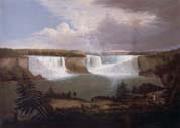 |
Alvan Fisher
|
|
American Painter, 1792-1863, American painter. Soon after he left the tutelage of John Ritto Penniman (c. 1782-1841), he began to paint genre landscapes such as Winter in Milton, Massachusetts (1815; Montclair, NJ, A. Mus.), which depicts a man on a horse-drawn sleigh enjoying the beauty of a fresh New England snowfall. |
|
|
|
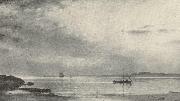 |
Amaldus Clarin Nielsen
|
|
(23 May 1838 - 10 December 1932) was a Norwegian painter.
He was born in Halse as a son of shipmaster and merchant Niels Clemetsen Nielsen (1795 - 1845) and his wife Andrea Marie Møller (1802 - 1866). He grew up in Mandal in Vest-Agder county, Norway. He lived most of his childhood and adolescence without a father. He received some tuition from a traveling drawing teacher and traveled to Copenhagen to study in 1854
|
|
|
|
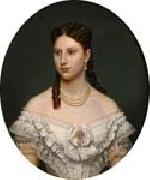 |
Amalia Lindegren
|
|
(22 May 1814 in Stockholm, died 27 December 1891 in Stockholm, was a Swedish artist and painter, from 1856 a member of the Royal Swedish Academy of Arts.
At the age of three, she was left an orphan after her mothers death and adopted by the widow of her alleged biological father, Benjamin Sandel. Her position as a child was somewhat humiliating, as a form of charity object for the upper classes, and in her later work, her paintings of sad little girls is believed to be inspired by her childhood.
Her drawings made the artist and art teacher Carl Gustaf Qvarnström include her as one of the four women accepted as students at the academy in 1849, and in 1850, she became the first woman given an art scholarship from the academy to study art in Paris, which she did at the studies of Coignet and Tissier; she also studied in D??sseldorf and Menich before she returned to Sweden in 1856, were she was elected to the academy |
|
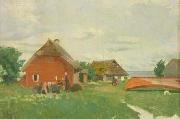 |
Amandus Adamson
|
|
(12 November 1855, Uuga-Rätsepa, near Paldiski -26 June 1929, Paldiski) was an Estonian sculptor and painter.
Born into a seafaring family, Adamson excelled in wood carving as a child. He moved to St. Petersburg in 1875 to study at the Imperial Academy of Arts under Alexander Bock. After graduation he continued to work as a sculptor and teacher in St. Petersburg, with an interruption from 1887 through 1891 to study in Paris and Italy, influenced by the French sculptors Jules Dalou and Jean-Baptiste Carpeaux.
Adamson produced his best-known work in 1902. His Russalka Memorial, dedicated to the 177 lost sailors of the Ironclad warship Russalka, features a bronze angel on a slender column. The other work is architectural. His four allegorical bronzes for the Eliseyev department store in St. Petersburg (for architect Gavriil Baranovsky), and the French-style caryatids and finial figures for the Singer House (for architect Pavel Suzor) are major components of the "Russian Art Nouveau" visible along Nevsky Prospekt. |
|
|
|
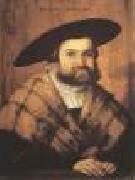 |
AMBERGER, Christoph
|
|
German Painter, ca.1500-1562
German painter and draughtsman. His family came from the Upper Palatinate. He served his apprenticeship in Augsburg, probably with Leonhard Beck, whose daughter Barbara he married. He became a master on 15 May 1530 but rarely signed his work. He was in northern Italy and Venice c. 1525-7. His full-length pendant portraits of a husband and wife (both 1525; Vienna, Ksthist. Mus.) show Venetian influence, and the portrait of Anton Welser (1527; priv. col., see 1980 exh. cat., p. 98) is in the Italian style. According to Sandrart, during the Imperial Diet of 1530 in Augsburg Amberger painted a portrait of Emperor Charles V to the Emperor's satisfaction, but the surviving work (Berlin, Gem?ldegal.) dates from 1532, based on the age given. In the decades that followed, Amberger was the favourite portrait painter of ambitious merchant families, such as the Fugger, who belonged to guilds but were connected with the nobility by family or marriage ties. |
|
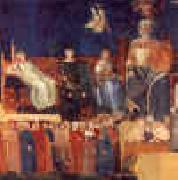 |
Ambrogio Lorenzetti
|
|
Italian Byzantine Style Painter, ca.1290-1348
Ambrogio Lorenzetti (or Ambruogio Laurati; c. 1290 ?C June 9, 1348) was an Italian painter of the Sienese school. He was active between approximately from 1317 to 1348. His elder brother was the painter Pietro Lorenzetti.
His work shows the influence of Simone Martini, although more naturalistic. The earliest dated work of the Sienese painter is a Madonna and Child (1319, Museo Diocesano, San Casciano). His presence was documented in Florentine up until 1321. He would return there after spending a number of years in Siena.
The frescoes on the walls of the Hall of the Nine (Sala dei Nove) or Hall of the Peace (Sala della Pace) in the Palazzo Pubblico of Siena are one of the masterworks of early renaissance secular painting. The "nine" was the oligarchal assembly of guild and monetary interests that governed the republic. Three walls are painted with frescoes consisting of a large assembly of allegorical figures of virtues in the Allegory of Good Government . In the other two facing panels, Ambrogio weaves panoramic visions of Effects of Good Government on Town and Country, and Allegory of Bad Government and its Effects on Town and Country (also called "Ill-governed Town and Country"). The better preserved "well-governed town and country" is an unrivaled pictorial encyclopedia of incidents in a peaceful medieval "borgo" and countryside.
The first evidence of the existence of the hourglass can be found in one of his paintings.
Like his brother, he is believed to have died of bubonic plague 1348. Giorgio Vasari includes a biography of Lorenzetti in his Lives. |
|
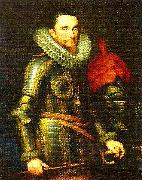 |
ambrogio spinola
|
|
Ambrogio Spinola var italienare, fodd i Genua 1569 han utvecklades snabbt till en av tidens framsta legoknektsanforare eller kondottiarer |
|
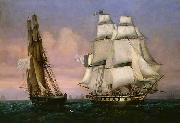 |
Ambroise-Louis Garneray
|
|
(19 February 1783 - 11 September 1857) was a French corsair, painter and writer. He served under Robert Surcouf and Jean-Marie Dutertre, and was held prisoner by the British for eight years.
Garneray was born in Paris (on Rue Saint-Andre-des-arts, in the Latin Quarter) on 19 February 1783. He was the elder son of Jean-François Garneray (1755-1837), painter of the king, who was pupil of Jacques-Louis David. At thirteen, he joined the Navy as a seaman, encouraged by his cousin, Beaulieu-Leloup, commander of the frigate Forte ("the Stout one"). Garneray sailed from Rochefort to the Indian Ocean with the frigate division under Sercey, to which the Forte belonged.
Garneray took part in the various campaigns of Sercey division and witnessed the hardship it met in the battle against Arrogant and Victorious. He then served in 1798 on the corvette Brûle Gueule ("Mouth burner"), which patrolled with the frigate Preneuse ("the Taker"). Returning from this campaign, the Brûle Gueule and Preneuse were chased by a British squadron comprising two ships of the line, one frigate and one corvette; the French flew into a creek near Black River whose shallow waters prevented the British from pursuing. The next day, the British squadron attacked; the French had established strong defensive positions by installing the unusable batteries of their ships ashore, and repelled the British squadron.
In 1799, Garneray was promoted to quartermaster and "first painter of the edge" on the Preneuse under captain Jean-Marthe-Adrien l'Hermite. The frigate was the last French official force in the Indian Ocean. This patrol went into trouble, in spite of an exceptional combat against the British ship of the line the Jupiter. Returning to Mauritius, her crew suffered from scurvy, and the Preneuse had to be kept quarantined and had to return to the British forces making the blockade of the island. Garneray escaped captivity by regaining the coast with the stroke. In spite of the disaster, Garneray kept longstanding admiration and friendship for to Lhermitte, whom he would continue to visit until his death 1826.
Garneray: Capture of Kent by SurcoufFor lack of official ships, Garneray joined the Confiance ("the Trust") of Robert Surcouf as an ensign, from April at December 1800. He took part in the capturing and boarding the Kent in October 1800. It was the only time where Garneray made money as a sailor. Upon returning from patrol, he invested his share in a slave trading ship, l'Union, on which he was a first mate.
He sailed on various trading ships during the peace of Amiens, after which he served aboard the Pinson ("the Finch"), a cutter based in Île Bourbon. He replaced the commander when he died, and was shipwrecked shortly thereafter. He then served on the corsair Tigre du Bengale and eventually on the frigate Atalante attached to the squadron of Linois. He later served on the Belle Poule ("beautiful chick"), and was aboard when she was captured by the British in March 1806. Wounded, Garneray was led in England and spent the eight following years on prison hulks off Portsmouth (on the Protee, the Couronne ("Crown") and the Vengeance. He was able to improve his standard of living by selling paintings to a British merchant.
A statement attributed to him goes: "But for piracy, I believe that I practiced about all kinds of navigation".
|
|
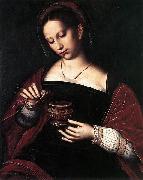 |
Ambrosius Benson
|
|
(c.1495/1500, Ferrara or Milan - 1550, Flanders) was an Italian painter who became a part of the Northern Renaissance.
While many surviving paintings have been attributed, there is very little known of him from records, and he tended not to sign his work. He is believed to be responsible for mainly religious art, but also painted portraits on commission. He sometime painted from classical sources, often setting the figures in modern-dress, or a contemporary domestic setting. In his lifetime he was successful; he had a large workshop, his work was sold internationally and he was especially popular in Spain.
Benson became popular as a source for pastiche with 19th century painters, who are sometimes known as the "followers of Benson". In particular his many variations of the Magdalen and Sibilla Persica, were further copied and became popular with contemporary buyers. Many have retained their relative value and held in the National Gallery, London and command high prices at Sotheby's
|
|
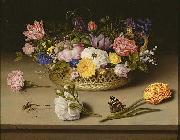 |
Ambrosius Bosschaert
|
|
(Antwerp, January 18, 1573?CThe Hague, 1621) was a still life painter of the Dutch Golden Age.He started his career in Antwerp, but spend most of it in Middelburg (1593?C1613), where he became dean of the painters' guild. He later worked in Amsterdam (1614), Bergen op Zoom (1615?C1616), Utrecht (1616?C1619), and Breda (1619). He specialised in painting still lifes with flowers. In 1587, Ambrosius Bosschaert moved from Antwerp to Middelburg with his family because of the threat of religious persecution. At the age of twenty-one, he joined the cityes Guild of Saint Luke. Not long after, Bosschaert had established himself as a leading figure in the fashionable floral painting genre.
|
|
 |
Ambrosius Holbein
|
|
1494-1519
German
Ambrosius Holbein Gallery
Ambrosius Holbein (c. 1494 ?C c. 1519) was a German and Swiss artist in painting, drawing and printmaking. He was the elder brother, by about three years, of Hans Holbein the Younger and like his brother was born in Augsburg (which today is in Bavaria, but then was a free imperial city), a center of art, culture and trade at that time. His father Hans Holbein the Elder was a pioneer and leader in the transformation of German art from the Gothic to the Renaissance style. In his studio both his sons, Ambrosius and Hans, received their first painting lessons as well as the an introduction to the crafts of the goldsmith, jeweller and printmaker.
Portrait of a Boy with Blond Hair, 1516, BaselIn 1515 Ambrosius lived in the Swiss town of Stein am Rhein, where he helped a Schaffhausen painter named Thomas Schmid with the murals in the main hall of the St George monastery. The next year saw Ambrosius, as well as his brother Hans, in Basel, where he initially worked as a journeyman in Hans Herbster??s studio. In 1517 he was enrolled in a register of the Basel painters' guild and in 1518 he was naturalized as a citizen there.
The Portrait of a Boy with Blond Hair and its companion, the Portrait of a Boy with Brown Hair, are among Ambrosius?? best works of this period. Both are nowadays in the Basel Kunstmuseum.
Ambrosius Holbein ranks among the most important of Basel??s illustrators and prominent „small formats?? artists. |
|
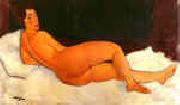 |
Amedeo Modigliani
|
|
Italian Expressionist Painter and Sculptor, 1884-1920
Amedeo Clemente Modigliani (July 12, 1884 ?C January 24, 1920) was an Italian artist of Jewish heritage, practicing both painting and sculpture, who pursued his career for the most part in France. Modigliani was born in Livorno (historically referred to in English as Leghorn), in northwestern Italy and began his artistic studies in Italy before moving to Paris in 1906. Influenced by the artists in his circle of friends and associates, by a range of genres and art movements, and by primitive art, Modigliani's œuvre was nonetheless unique and idiosyncratic. He died in Paris of tubercular meningitis, exacerbated by poverty, overworking, and an excessive use of alcohol and narcotics, at the age of 35. |
|
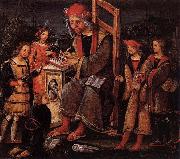 |
Amico Aspertini
|
|
(c. 1474 - 1552) is an Italian Renaissance painter whose complex, eccentric, and eclectic style anticipates Mannerism. He is considered among the first of the Bolognese School of painting.
He was born in Bologna to a family of painters (Guido Aspertini and Giovanni Antonio Aspertini, his father), and studied under masters such as Lorenzo Costa and Francesco Francia. He is briefly documented in Rome between 1500 - 1503, returning to Bologna and painting in a style influenced by Pinturicchio. In Bologna in 1504, he joined Francia and Costa in painting frescoes for the newly restored Oratory of Santa Cecilia in San Giacomo Maggiore, a work commissioned by Giovanni II Bentivoglio.
In 1507-09, he painted a fresco cycle in San Frediano in Lucca. Asperini painted in 1508-1509 the splendid frescoes in the Chapel of the Cross in the Basilica di San Frediano in Lucca. Aspertini was also one of two artists chosen to decorate a triumphal arch for the entry into Bologna of Pope Clement VII and Emperor Charles V in 1529.
|
|
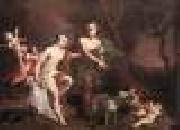 |
AMIGONI, Jacopo
|
|
Italian Rococo Era Painter, ca.1682-1752
He was born in Naples or Venice. Amigoni initially painted both mythological and religious scenes; but as the panoply of his patrons expanded northward, he began producing many parlour works depicting gods in sensuous languor or games. His style influenced Giuseppe Nogari. Among his pupils were Charles Joseph Flipart, Michelangelo Morlaiter, Pietro Antonio Novelli, Joseph Wagner, and Antonio Zucchi.
Starting in 1717, he is documented as working in Bavaria in the Castle of Nymphenburg (1719); in the castle of Schleissheim (1725-1729); and in the Benedictine abbey of Ottobeuren. He returned to Venice in 1726. His Arraignment of Paris hangs in the Villa Pisani at Stra. From 1730 to 1739 he worked in England, in Pown House, Moor Park and in the Theatre of Covent Garden. From there, he helped convince Canaletto to travel to England by telling him of the ample patronage available.
From his travel to Paris in 1736, he met the celebrated castrato named Farinelli. Later in Madrid, he was to paint a self-portrait with the singer and entourage. He also encountered the painting of François Lemoine and Boucher.
In 1739 he returned to Italy, perhaps to Naples and surely to Montecassino, in whose Abbey existed two canvases (destroyed during World War II). Until 1747, he travelled to Venice to paint for Sigismund Streit, for the Casa Savoia and other buildings of the city. In 1747 he left Italy and established himself in Madrid. There he became court painter to Ferdinand VI of Spain and director of the Royal Academy of Saint Fernando. He died in Madrid. |
|
 |
AMMANATI, Bartolomeo
|
|
Italian Mannerist Sculptor, 1511-1592
Italian sculptor and architect. He was a major figure in Italian art in the second and third quarters of the 16th century. His extensive travels in north and central Italy gave him an unequalled understanding of developments in architecture and sculpture in the era of Mannerism. His style was based inevitably on the example of Michelangelo but was modified by the suaver work of Jacopo Sansovino. In both sculpture and architecture Ammanati was a highly competent craftsman, and his masterpieces, the tombs of Marco Mantova Benavides and two members of the del Monte family, the Fountains of Juno and Neptune and the courtyard of the Palazzo Pitti, are among the finest works of the period. |
|
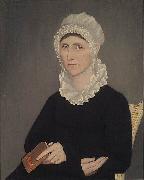 |
Ammi Phillips
|
|
(1788-1865), a self-taught New England portrait painter, is regarded as one of the most important folk artists of his era.
Phillips was born in Colebrook, Connecticut, and began painting portraits as early as 1810. He worked as an itinerant painter in Connecticut, Massachusetts, and New York for five decades.
In 1924, a group of portraits of women, shown leaning forward in three-quarter view and wearing dark dresses, were displayed in an antique show in Kent, Connecticut. The anonymous painter of these strongly colored works, which dated from the 1830s, became known as the "Kent Limner," after the locality where they had come to light.
Stylistically distinct from those of the "Kent Limner," a second group of early-19th-century paintings emerged after 1940 in the area near the Connecticut?CNew York border. Attributed at the time to an unknown "Border Limner," these works, dating from the period 1812?C1818, were characterized by soft pastel hues, as seen in the portrait of Harriet Leavens, now in the Fogg Art Museum, Harvard University.
It was not until 1968 that Ammi Phillips's identity as the painter of both groups of portraits was established. Additional works were identified, showing the artist's transition from the delicate coloration of the Border period to the bold and somber works that followed. |
|
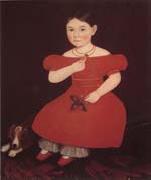 |
Amy Philip
|
|
1788-1865,is a British actress. She is best known for her role as Jessica Arnold in the BBC school drama, Grange Hill, which she acted between 1994 and 1998. In Grange Hill, Amy character was from a middle-class family and was sent to Grange Hill from an exclusive girls school when her father business fell on hard times. She quickly adapted to life at Grange Hill and won a firm following among male fans. In 1996, viewers saw the previously feisty Jessica become bedridden with chronic fatigue syndrome (or M.E. as the condition was then popularly known). Simcock appeared in just the first four episodes of the 1996 series, with Jessica sent to the USA to recuperate. Despite returning to Grange Hill as an integral part of the 1997 series, where Jessica would cause a stir as editor of the school magazine, Simcock appeared in just two episodes of the 1998 series, the explanation being that Jessica had left Grange Hill in favour of sixth form college. In September 1997, Simcock appeared in the CITV comedy drama Knight School as Lady Elizabeth de Gossard, having now changed her professional name to Amy Phillips. Post-Grange Hill, Phillips has continued to make regular occasional appearances in various TV shows, the most notable being as Beth Partridge in the BBC series Rescue Me. She has also appeared in the Hollywood movie The Freediver. |
|
|
|
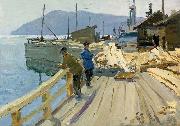 |
Anatoli Ilych Vasiliev
|
|
Anatoli Ilych Vasiliev (Russian: 18 March 1917, Petrograd (former Saint Petersburg), Russian Empire e June 4, 1994, Saint Petersburg, Russian Federation) was a Russian and Soviet realist painter, who lived and worked in Leningrad. He was a member of the Saint Petersburg Union of Artists (before 1992 named as the Leningrad branch of Union of Artists of Russian Federation), and regarded as one of the representatives of the Leningrad school of painting, most famous for his historical paintings and etudes done from nature.
|
|
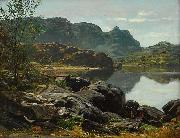 |
Anders Askevold
|
|
(25 December 1834 - 22. October 1900) was a Norwegian landscape painter. Anders Askevold was best known as an animal and landscape painter.
Anders Monsen Askevold was born in Askvoll, in Sunnfjord, Norway. He was the second oldest of ten siblings. His father was a teacher. His early training started at the age of thirteen in Bergen under Hans Leganger Reuch (1800-1854) . He was educated as a painter in Desseldorf, but continued his studies in Paris and Munich. Askevold came to Desseldorf in 1855 and stayed for 3 years. He trained in Desseldorf under Professor Hans Gude from 1855 until 1859. He was known as a member of the Desseldorf school with others like Adelsteen Normann. From 1861 to 1866 he was in Paris. In 1866 Askevold moved back to Norway and settled in Bergen. After this he moved back to Desseldorf where he would spend his winters in Germany and his summers in Norway. |
|
|
|
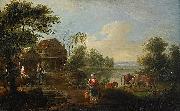 |
Anders Holm
|
|
(1751 -1824 ) - Painter
is a comedy writer and one of the stars and creators of the Comedy Central show Workaholics. Originally from Evanston, Illinois, Holm graduated from the University of Wisconsin - Madison and the Second City Conservatory in L.A. He, along with fellow Workaholics creators Blake Anderson, Adam DeVine and Kyle Newacheck form the sketch-comedy group, Mail Order Comedy. He also starred in a film, the Legend of Awesomest Maximus.
|
|
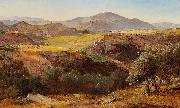 |
Anders Lunde
|
|
(1809- 1886 )
painted Italiensk Bjerglandskab. Parti fra omegnen af Subiaco
Anders Christian Lunde |
|
|

